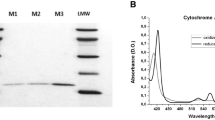Abstract
The role of pH in uncoupling the electron-flux between oxidoreductase and cytochrome P450 (P450) or P450 and cyclosporine (CyA) and resulting in the generation of oxygen radicals was investigatedin vitro in rat and human liver microsomal preparations. Since the electron-flux from NADPH to cytochrome c via oxidoreductase showed a fairly constant reduction activity from pH 7.0–9.5, the generation of oxygen radicals at the level of P450-Cyclosporine (instead of oxidoreductase-P450) was investigated. The effects of increasing pH on oxygen radical formation was measured by the thiobarbituric acid assay (TBA) and the adrenochrome reaction. The trends in oxygen radical production were correlated with benzphetamine metabolism (production of formaldehyde) and CyA metabolism (analyzed by high performance liquid chromatography). The TBA assay showed increased MDA-detected lipid peroxidation (unrelated to autooxidation) at pH<8.0 and pH>8.0 (rat and human, respectively) while the adrenochrome reaction showed decreased oxygen radical production. When these results were compared to benzphetamine (a substrate of P450 2B and 3A) metabolism and CyA (a substrate of P450 3A) metabolism, increased metabolism followed the pH-dependent trend of MDA-detected lipid peroxidation. Benzphetamine metabolism with formaldehyde production and depletion of parent compound during CyA metabolism were increased at pH<8.0 in the rat samples and at pH>8.0 in the human samples. This parallel relation suggests that the increased metabolism of CyA at lower pH in rats and higher pH in humans may be the result of favorable interactions of P450 with Cyclosporine that also result in increased oxygen radical-related lipid peroxidation.
Similar content being viewed by others
Abbreviations
- CCl4 :
-
carbon tetrachloride
- CyA:
-
cyclosporin A
- EDTA:
-
ethylenediaminetetraacetic acid
- HPLC:
-
high performance liquid chromatography
- MDA:
-
malondialdehyde
- MFO:
-
mixed function oxidase
- MICROS:
-
microsomes
- NADPH:
-
nicotinamide adenine dinucleotide phosphate
- TBA:
-
thiobarbituric acid
References
Jones MC, Whiting PH, Innes A, Propper DJ, Edward N, Catto GRD: Biochemical abnormalities in serum and urines from renal transplant recipients receiving cyclosporine. Transplant Proc 21: 1487–1489, 1989
Whiting PH, Simpson JG, Davidson RJL, Thomson AW: Pathological changes in rats receiving cyclosporin A at imrnunotherapeutic dosages for 7 weeks. Br J Exp Pathol 64: 437–444, 1983
Ahmed SS, Strobel HW, Napoli K, Grevel J: Adrenochrome reaction implicates oxygen radicals in metabolism of cyclosporine A and FK-506 in rat and human liver microsomes. J Pharm and Exp Therap 265(3): 1047–1054
Maurer G: Metabolism of cyclosporine. Transplant Proc 17: 19–26, 1985
Berthault-Peres P, Bonfils C, Fabre G, Just S, Cano J-P, Maurel P: Metabolism of cyclosporin A. II. Implication of the macrolide antibiotic inducible cytochrome P-450 3c from rabbit liver microsomes. Drug Metab Dispos 15: 391–398, 1987
Lensmeyer GL, Wiebe DA, Carlson IH: Identification and analysis of nine metabolites of cyclosporine in whole blood by liquid chromatography. 2: Comparison of patients' results. Clin Chem 33: 1851–1855, 1987
Grogan J, Shou M, Zhou D, Chen S, Korzekwa KR: Use of aromatase (CYP 19) metabolite ratios to characterize electron transfer from NADPH-cytochrome P450 reductase. Biochem 32: 12007–12012, 1993
Hille R, Fee JA, Massey V: Equilibrium properties of xanthine oxidase containing FAD analogs of varying oxidation-reduction potential. J Biol Chem 256(17): 8933–8940, 1981
Sun J, Strobel HW: Aging affects the drug metabolism system of rat liver, kidney, colon, and lung in a different fashion. Experimental Gerontology 21: 523–534, 1986
Dignam JD, Strobel HW: NADPH-cytochrome P-450 reductase from rat liver: purification by affinity chromatography and characterization. Biochemistry 16: 1116–1123, 1977
Omura T, Sato R: CO Difference Spectrum. J Biol Chem 239: 2379–2385, 1964
Smith PK, Krohn RI, Hermanson GT, Mallia AK, Gartner FH, Provenzano MD, Fujimoto EK, Goeke NM, Olson BJ, Klenk DC: BCA Protein Assay. Anal Biochem 150: 76–85, 1985
Kirkpatrick DT, Guth DJ, Mavis RD: Detection ofin vivo lipid peroxidation using the thiobarbituric acid assay for lipid hydroperoxides. J Biochem Toxicol 1(1): 93–104, 1986
Knobelodh LM, Blondin GA, Lyford SB, Harkin JM: A rapid bioassay for chemicals that induce pro-oxidant states. J Appl Toxicol 10(1): 1–5, 1990
Ryffel B, Foxwell BM, Gee A, Greiner B, Woerly G, Mihatsch MJ: Cydosporin, relationship of side effects to mode of action. Transplant 46: 90S-96S, 1988
Serino F, Grevel J, Napoli KL, Kahan BD, Strobel HW: Generation of oxygen free-radicals during the metabolism of cyclosporine A: a cause-effect relationship with metabolism inhibition. Mol Cell Biochem 122: 101–112, 1993
Aust SD, Chignell CF, Bray TM, Kalyanaraman B, Mason RP: Contemporary issues in toxicology: free radicals in toxicology. Toxicol Appl Pharmacol 120: 168–178, 1993
McManus ME, Davies DS, Boobis AR, Grantham PH, Wirth PJ: Guanethidine N-oxidation in human liver microsomes. J Pharm Pharmacol 39(12): 1052–1055, 1987
Arthur JR, McPhail, DB, Goodman BA: Spin trapping of free radicals in homogenates of heart from selenium and vitamin E deficient rats. Free Radic Res Commun 4: 311–315, 1988
Nelson DR, Strobel HW: On the Membrane Topology of Vertebrate Cytochrome P450 Proteins. J Biol Chem 263: 6038–6050, 1988
Shen S, Strobel HW: Role of lysine and arginine residues of cytochrome P450 in the interaction between cytochrome P4502B1 and NADPH-cytochrome P450 reductase. Arch Biochem Biophys 304(1): 257–265, 1993
Barth SA, Inselmann G, Engemann R, Heidemann HT: Influences of Ginko biloba on cyclosporin A induced lipid peroxidation in human liver microsomes in comparison to vitamin E, glutathione and N acetylcystein. Biochem Pharmacol 41(10): 1521–1526, 1991
Boveris A: Determination of the production of superoxide radicals and hydrogen peroxide in mitochondria. Methods Enzymol 105: 429–435, 1984
Werringloer J: Assay of formaldehyde generated during microsomal oxidation reactions. In: S. Fleischer and L. Packer (ed.). Methods of Enzymology: Biological Oxidations: Microsomal, Cytochrome P-450, and Other Hemoprotein Systems. Academic Press Inc., New York, NY, pp. 297–302, 1978
Author information
Authors and Affiliations
Additional information
This work was supported by Grant No. CA-53191 from the National Cancer Institute DHHW
Rights and permissions
About this article
Cite this article
Ahmed, S.S., Napoli, K.L. & Strobel, H.W. Oxygen radical formation during cytochrome P450-catalyzed cyclosporine metabolism in rat and human liver microsomes at varying hydrogen ion concentrations. Mol Cell Biochem 151, 131–140 (1995). https://doi.org/10.1007/BF01322335
Received:
Accepted:
Issue Date:
DOI: https://doi.org/10.1007/BF01322335




